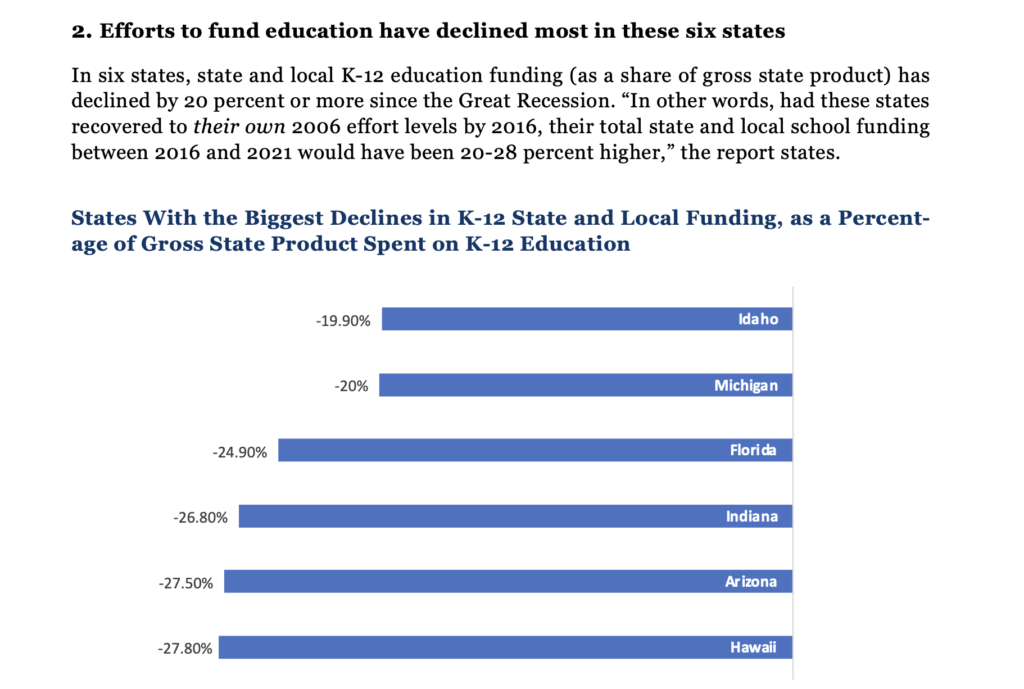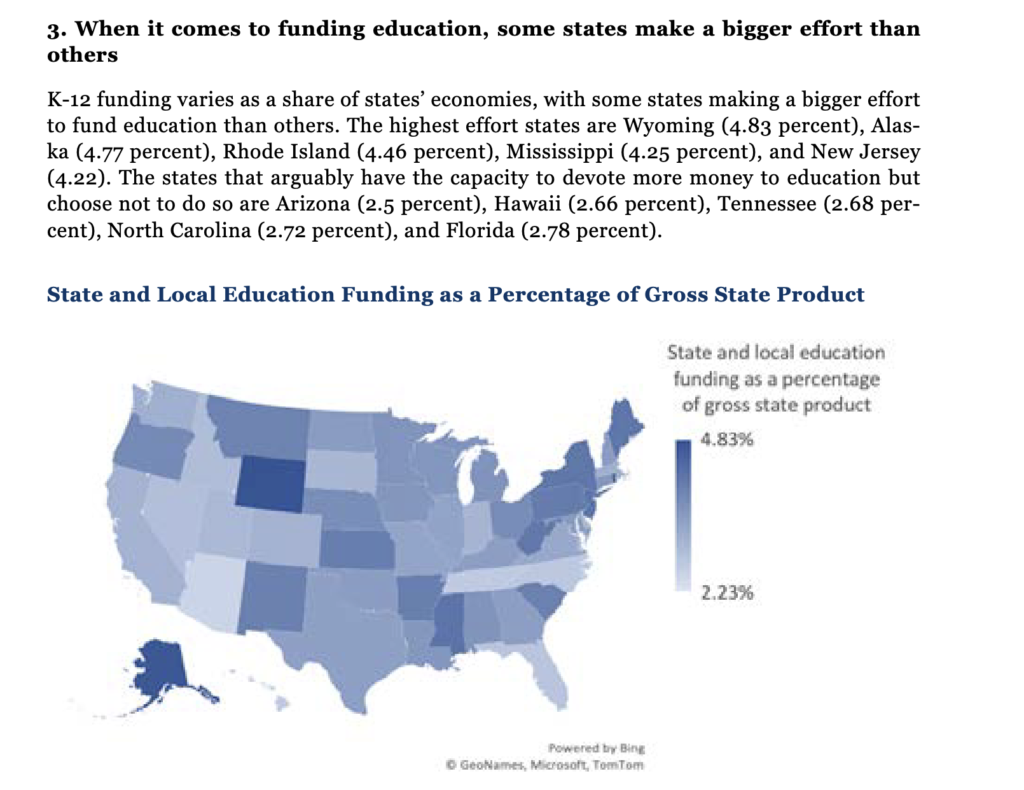Sue Kingery Woltanski: Florida Has The Capacity, But Not The Commitment, To Adequately Fund Its Public Schools
Sue Kingery Woltanski shows that Florida could fully fund its public schools if its legislators really wanted to. Reposted with permission.
A Look At The 2024-25 K-12 Budget
In January, a former staff member for Governor Rick Scott bragged to a roomful of school board members that they had “invented” the phrase “historic education funding.” They chuckled while they explained that one student or one dollar more than last year qualified as “historic.”
Sadly, this reflects Florida’s recent commitment to properly funding its public education system. It is more about how it can be spun politically, than a true commitment to a quality system. Today’s blog is about Florida’s “historic” 2024-25 K-12 education budget.
On May 23, 2024, Governor DeSantis addressed a Florida homeschool convention, telling the audience that Florida’s budget surplus is SO big “I don’t know what to do with all this money!”
This year, 20,000 of Florida’s homeschooled students were able to access “Personalized Education Program” Education Savings Account (ESA) vouchers worth approximately $8,000 per student. In 2024-25, an additional 40,000 PEP students will be eligible for the program funded through a tax credit program. The estimated cost for the program in the upcoming year is $480 million, a 200% increase over the current fiscal year.
On June 21st, Governor DeSantis announced that Florida’s real Gross Domestic Product (GDP) grew by 21.9 percent from the first quarter of 2019 (when he first took office) to the first quarter of 2024, nearly double the national growth rate of 11.1 percent during the same period. Florida, he said, remains one of the world’s strongest economies, with an annual GDP of nearly $1.3 trillion. On the site formerly known as Twitter, DeSantis called the results “pretty remarkable” and thought it “would be nice if those folks in Washington would learn a thing or two from what we’re doing down here in Florida.”
Florida’s economy is booming, Florida now holds $17 Billion in reserves and our Governor is rapidly paying down state debt (Since Governor Ron DeSantis took office, the State of Florida has paid down over 36% of its overall outstanding tax-supported state debt). Florida’s overall debt level, including tax- and self-supported debt, is at a 25-year low.
After vetoing nearly $1 billion ($949.6 million), Florida’s 24-25 budget has less overall spending than the current 23-24 budget, something DeSantis says “few other governments in the world can claim… Florida leads the way, once again.”
As the saying goes, budgets reflect priorities and, once again, Florida’s 2024-25 budget fails to prioritize public education. Despite lawmakers’ insistence that Florida has increased education spending every year for the past decade, when you consider the impacts of inflation, population growth and diversion of public funds to private vouchers, those increases vanish. This year’s budget is no different.
The high water mark for K-12 spending in Florida was the 2007-08 Budget, just prior to the Great Recession. When the Recession hit, state governments had to deal with massive and swift drops in revenue and, across the nation, education budgets were slashed. Since that time, Florida’s education system has never recovered.
The School Finance Indicators Database (SFID) is a public collection of data and research on U.S. K-12 school finance compiled by researchers from the Albert Shanker Institute, University of Miami School of Education and Human Development, and the Rutgers University Graduate School of Education. They publish an annual report summarizing the state K-12 finance systems in the United States. The most recent report, The Adequacy and Fairness of State School Finance Systems was published January 2024. The images in this post are from that report.
According to the SFID report, Florida is one of 39 states that devote a smaller share of their economies to their K-12 schools than they did before the 2007-09 recession. Florida (at (-24.9 percent) was one of 6 states noted to have experienced enormous proportional “losses” between 2016-2021. In other words, the report notes, had Florida’s K-12 spending recovered to its 2006 effort levels by 2016, its total state and local school funding between 2016 and 2021 would have been 24.9 percent higher.

The report also reports that “About 60 percent of the nation’s students in “chronically underfunded” districts are in just 10 states which serve only 30 percent of the nation’s students. Florida is one of those state. “Three of these states (Florida, Nevada, and North Carolina) are comparatively low fiscal effort states, which suggests they have the capacity to increase funding substantially but are not doing so,” the report reads. Florida spends 2.78 percent of its economic capacity (gross state product) on its K-12 public schools (0.75 percentage points lower than the unweighted U.S. average of 3.53 percent) and ranks 4th in the nation for fiscal effort.

Public education funding in Florida has never recovered from Great Recession cuts, despite massive budget surpluses over the last 2 years. Florida’s 2007-08 Budget included an FEFP (Florida Education Finance Program) with a per pupil spending of $7305.79, which adjusted for inflation would equal $11066.36 in today’s dollars, far higher than the $8,958.59 offered in today’s 2024-25 FEFP. If the inflation adjusted 07-08 per pupil spending were used to fund today’s student population, the total FEFP Funding would be $35.08 Billion, almost 25% higher than next year’s 24-25 Budget.
Under DeSantis, Florida has continued to defund its public schools by failing to adjust funding with inflation. When DeSantis was elected in 2018, per pupil funding (unweighted FTE) was $7408 which, adjusted for inflation, would be $9265.47 in today’s dollars – more than $300/pupil higher than the $8958.59 offered in the upcoming 2024-25 FEFP. If the inflation adjusted 2018-19 per pupil spending were used to fund today’s student population, the total FEFP Funding would be $29.3 Billion, almost $1 Billion than next year’s 24-25 Budget.
In his 2024-24 budget press release, DeSantis celebrated:
- $1.25 billion (an increase of $201.8 million) in funding to provide salary increases for teachers and other instructional personnel;
- $1.7 billion in funding for early child education, including $438 million for Voluntary Pre-Kindergarten (VPK) (up from $427 million in the 23-24 budget, a 2.6% increase); and
- An historic $28.4 billion in funding for the K-12 public school system.
Let’s look a little closer at each of these claims.
$1.25 billion (an increase of $201.8 million) in funding to provide salary increases for teachers and other instructional personnel: Florida has 203,500 instructional staff. The Teacher Salary Increase Allocation of $201.8 million represents $991/instructor, a 1.86% increase for the average teacher salary of $53,098. Compare this 1.86% average pay increase to the across-the-board 3.0 percent pay increase offered to all state employees in the 2024-25 budget. This is the third year in a row DeSantis and the Legislature have deliver such increases for state employees. A 3 percent pay increase for Florida’s average teacher would be $1,593. Read more about the teacher salary increases here.
$1.7 billion in funding for early child education, including $438 million for Voluntary Pre-Kindergarten (VPK): This is a 2.6% increase from $427 million in the 23-24 budget. Again, when you consider inflation the increase is anemic. To keep up with inflation the state would need to fund $440 million for VPK.
An historic $28.4 billion in funding for the K-12 public school system: As noted above, the high water mark for K-12 spending in Florida was the 2007-08 Budget, just prior to the massive cuts associated with the Great Recession. This year’s “historic” $28.4 billion budget also $2.8 Billion for “Family Empowerment” vouchers for 315,892 private school students, an $800 million/39% increase in voucher funding over the current fiscal year. The majority of the new students receiving vouchers (almost 70% according to an Education Week report) were never enrolled in public schools meaning new funding needs to be “found” for these students. The increased voucher enrollment accounts for 75% of this year’s predicted increase in student population (unweighted FTE) in the state funding formula. More than 10% of our state’s K-12 funding is now going to unaccountable private schools and homeschoolers.
Again, budgets reflect priorities and, when it comes to funding public schools, Florida’s priority is less about a commitment to adequately funding a uniform, efficient, safe, secure, and high quality system of free public schools and more about how it can give the appearance of doing so. Florida’s schools have yet to be made whole from massive budget cuts due to the Great Recession. K-12 funding continues to lag behind inflation. Increased spending is being funneled to private options.
In 2007, Florida was funding its schools at about the national average. Now, average teacher pay is 50th in the nation (just above West Virginia’s) and per-pupil spending is 49th in the nation. With a an annual GDP of nearly $1.3 trillion, low state debt and and $17 Billion budget surplus, Florida has the economic capacity to adequately fund its school system but, it appears, that is not a priority.